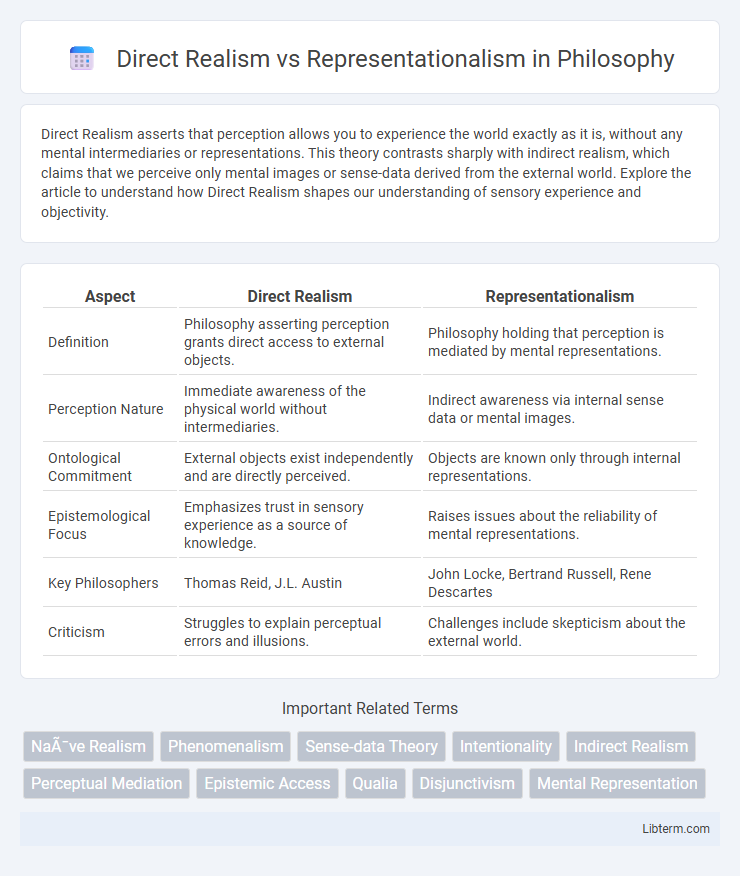Direct Realism asserts that perception allows you to experience the world exactly as it is, without any mental intermediaries or representations. This theory contrasts sharply with indirect realism, which claims that we perceive only mental images or sense-data derived from the external world. Explore the article to understand how Direct Realism shapes our understanding of sensory experience and objectivity.
Table of Comparison
| Aspect | Direct Realism | Representationalism |
|---|---|---|
| Definition | Philosophy asserting perception grants direct access to external objects. | Philosophy holding that perception is mediated by mental representations. |
| Perception Nature | Immediate awareness of the physical world without intermediaries. | Indirect awareness via internal sense data or mental images. |
| Ontological Commitment | External objects exist independently and are directly perceived. | Objects are known only through internal representations. |
| Epistemological Focus | Emphasizes trust in sensory experience as a source of knowledge. | Raises issues about the reliability of mental representations. |
| Key Philosophers | Thomas Reid, J.L. Austin | John Locke, Bertrand Russell, Rene Descartes |
| Criticism | Struggles to explain perceptual errors and illusions. | Challenges include skepticism about the external world. |
Introduction to Direct Realism and Representationalism
Direct Realism asserts that perception involves a direct awareness of the external world, where objects are perceived exactly as they exist without any mental intermediaries. Representationalism, in contrast, suggests that perception is mediated by mental representations or sense-data, which stand in for external objects in the mind. These opposing theories address the fundamental nature of how consciousness relates to physical reality in the philosophy of perception.
Defining Direct Realism: Core Principles
Direct realism asserts that perception involves the immediate awareness of external objects as they truly exist, without any mental intermediaries or representations. It emphasizes that sensory experience is a direct interaction with the world, where objects are perceived in their actual form and location. This approach rejects the notion that perception is mediated by internal images or sense-data, insisting on a straightforward connection between the observer and reality.
The Foundations of Representationalism
Representationalism posits that perception involves mental representations that mediate our experience of the external world, grounding knowledge in internal cognitive structures rather than direct sensory contact. This theory relies on the premise that the mind constructs representations that correspond to, yet are distinct from, physical objects, emphasizing the interpretative nature of perception. Foundational texts in philosophy of mind and epistemology highlight representationalism's role in explaining illusions, hallucinations, and the subjective variability of perceptual experience.
Historical Development of Both Theories
Direct Realism traces back to ancient Greek philosophy, particularly Aristotle, who argued perception involves direct awareness of external objects. Representationalism emerged prominently in early modern philosophy with thinkers like Descartes and Locke, positing that perception is mediated by mental representations or ideas. The historical development reflects a shift from trusting direct sensory contact to emphasizing the mind's role in constructing perceptual experience.
Key Philosophers and Influential Works
Direct Realism, championed by philosophers such as Thomas Reid and J.J. Gibson, emphasizes immediate perception of objects without mental intermediaries in works like Reid's "Inquiry into the Human Mind." Representationalism, advocated by thinkers like John Locke and Bertrand Russell, argues perception involves internal representations or sense data, detailed in Locke's "An Essay Concerning Human Understanding" and Russell's "The Problems of Philosophy." The debate centers on whether perceptual experience connects directly with the external world or is mediated by mental constructs.
Differences in Perception and Reality
Direct Realism asserts that perception provides immediate awareness of the external world as it truly is, emphasizing a direct causal link between objects and sensory experience. Representationalism contends that perception is mediated by mental representations or sense data, meaning individuals never access the external world directly but only through internal constructs. The core difference lies in whether perception reveals reality itself (Direct Realism) or a brain-constructed model of reality (Representationalism).
Common Arguments for Direct Realism
Direct realism asserts that perception involves immediate awareness of the external world without any intervening mental representations. Key arguments supporting direct realism include the transparency argument, which posits that we perceive objects directly by focusing on their visible properties rather than mental images, and the common-sense argument that aligns with everyday experience of seeing objects as they truly are. Another significant point is the argument from perceptual variation, which explains perceptual differences by variations in conditions rather than by the presence of inner representations, emphasizing direct interaction with reality.
Major Criticisms Against Representationalism
Representationalism faces major criticisms for its reliance on mental representations, which may lead to skepticism about the external world since knowledge depends on interpreting internal images rather than direct experiences. Critics argue that this model struggles to explain the immediate nature of perception and how subjective representations accurately correspond to objective reality. The theory's dependence on intermediaries between perception and the world raises concerns about the potential for error and the loss of direct connection with objects.
Contemporary Debates and Applications
Contemporary debates on Direct Realism vs Representationalism center around the nature of perceptual experience, with Direct Realism asserting that perception involves immediate awareness of external objects, while Representationalism maintains perception is mediated by mental representations. Advances in cognitive neuroscience and philosophy of mind have spurred applications in artificial intelligence and virtual reality, where understanding the mechanisms of perception informs the design of immersive environments and perception-based AI algorithms. Current research examines how perceptual errors and illusions challenge Direct Realism, prompting hybrid theories that integrate representational content with direct perceptual access.
Conclusion: Evaluating the Competing Theories
Direct Realism asserts that perception grants immediate access to the external world, emphasizing a direct connection between the observer and objects, minimizing interpretative layers. Representationalism contends that perception involves mental representations mediating our experience, highlighting the role of cognitive processing and potential distortions. Evaluating these theories involves assessing empirical evidence from neuroscience and psychology, weighing the explanatory power for perceptual phenomena, and considering philosophical implications for knowledge and reality.
Direct Realism Infographic

 libterm.com
libterm.com